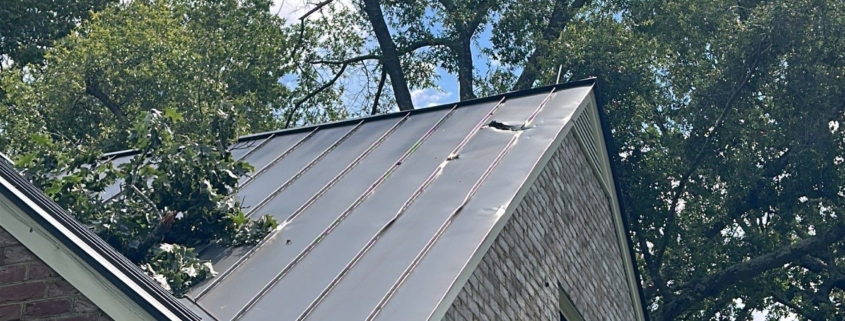Weathering the Storm: Understanding Residential and Commercial Roof Damage
The roof of any building is its first line of defense against the elements. From scorching sun to pounding rain, and from heavy snow to fierce winds, roofs withstand a barrage of weather conditions every day. However, when nature unleashes its full fury in the form of storms, roofs can sustain significant damage, posing safety risks and financial burdens to homeowners and businesses alike. In this blog, we delve into the various types of storm damage—hail, rain, wind, and overall storm impact—focusing on both residential and commercial properties.
Hail Damage:
Hailstorms can wreak havoc on roofs, especially those composed of asphalt shingles. Hailstones of various sizes pelt the surface, causing dents, cracks, and granule loss. These damages compromise the roof’s integrity, leading to leaks and, if left unaddressed, structural issues. Identifying hail damage often requires a professional inspection, as some signs may not be immediately visible from ground level. Insurance companies typically cover hail damage, making prompt assessment and repair crucial to prevent further deterioration and maximize insurance claims.
Rain Damage:
While rain may seem less menacing than hail, it can still cause significant harm to roofs, particularly if they are already compromised. Poorly maintained or damaged roofs are susceptible to leaks during heavy rainfall, allowing water to seep into the building’s interior. Over time, this water intrusion can result in mold growth, rotting of wooden structures, and ceiling damage. Regular roof inspections and maintenance help identify and rectify vulnerabilities before they escalate into costly repairs.
Wind Damage:
Strong winds during storms can uplift roofing materials, tear shingles, and even detach entire sections of the roof. Additionally, debris propelled by high winds can puncture or scratch the roof’s surface, further compromising its integrity. Commercial properties with flat or low-sloped roofs are particularly susceptible to wind damage, as the lack of pitch increases the likelihood of wind uplift. Prompt repairs following wind damage are essential to prevent water infiltration and structural issues.
Storm Impact: Storms often combine multiple elements—hail, rain, and wind—creating a perfect storm of destruction for roofs. The cumulative effect of these forces can result in widespread damage, necessitating comprehensive repairs or even roof replacement. Beyond the physical damage, storms can also disrupt business operations and displace homeowners, underscoring the importance of proactive measures to mitigate storm risks.
Mitigation and Preparedness: While it’s impossible to prevent storms, there are steps homeowners and businesses can take to minimize roof damage:
-
1. Regular Inspections: Schedule annual roof inspections by qualified professionals to identify and address any issues before they escalate.
-
2. Maintenance: Keep gutters clear, trim overhanging branches, and promptly replace damaged or missing shingles to maintain the roof’s integrity.
-
3. Reinforcement: Consider reinforcing the roof’s structure to withstand high winds and severe weather conditions, especially for commercial properties.
-
4. Insurance Coverage: Review your insurance policy to ensure adequate coverage for storm damage, including hail, rain, and wind.
-
5. Emergency Plan: Develop an emergency preparedness plan that outlines procedures for securing the property and addressing damage following a storm.
Storm damage on residential and commercial roofs is a serious concern, posing safety risks and financial implications for property owners. By understanding the various types of damage—hail, rain, wind, and overall storm impact—and implementing proactive measures, homeowners and businesses can better protect their properties and minimize the aftermath of severe weather events. From regular inspections and maintenance to comprehensive insurance coverage and emergency preparedness, investing in storm resilience is key to weathering the storm.

